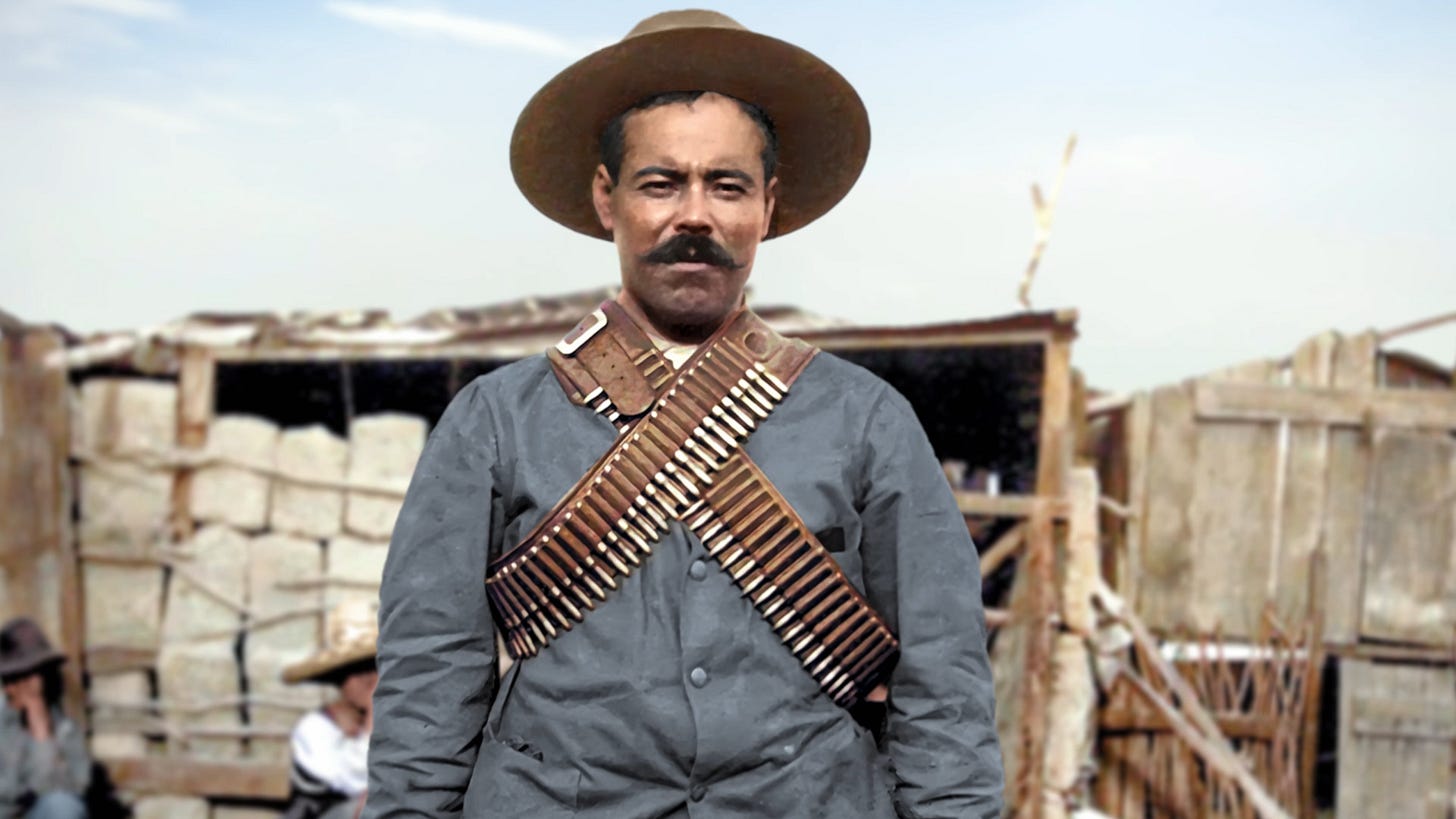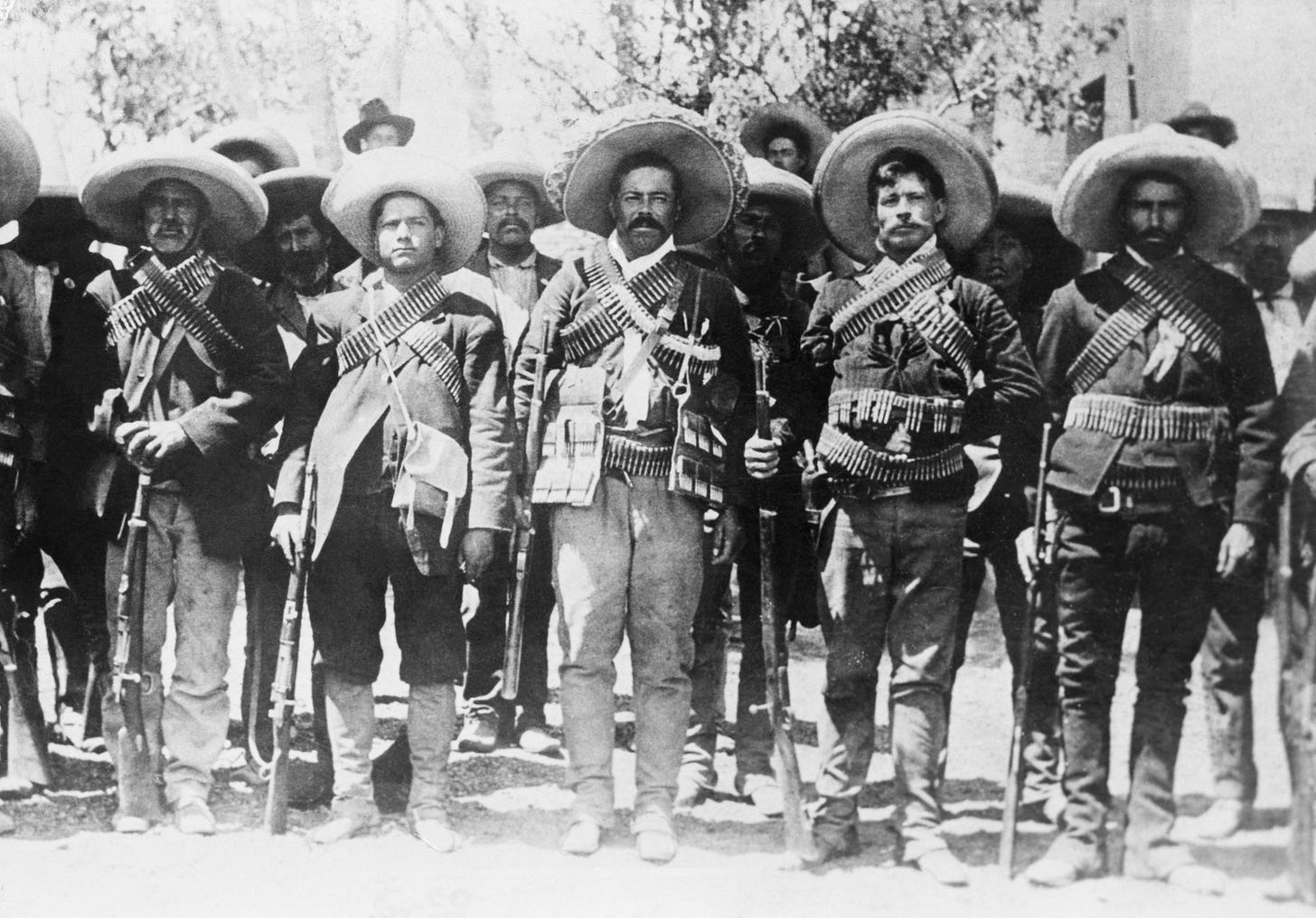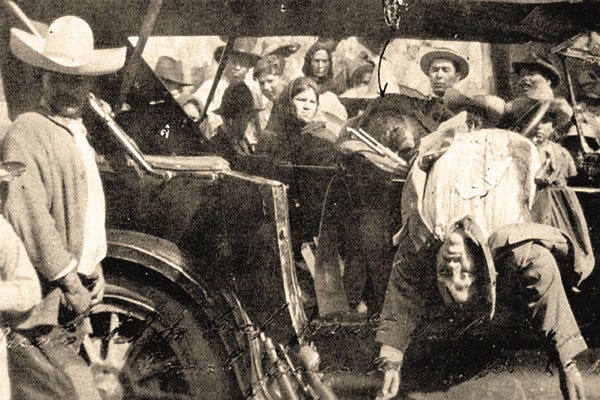July 20 - Pancho Villa: The Assassination of a Mexican Revolutionary
The Complexity of Human Nature: Struggle Between Intention and Action
This is the day Pancho Villa, Mexican Revolutionary general, was assassinated in 1923.
In today's lesson, we explore the complex legacy of Pancho Villa and the internal struggles we all face. How do we reconcile the good we intend with the actions we sometimes take? What can a controversial historical figure teach us about our own nature?
"For I do not do the good I want to do, but the evil I do not want to do—this I keep on doing." - Romans 7:19 (NIV)
This Date in History
The crack of gunfire shattered the quiet afternoon in Parral, Chihuahua, on July 20, 1923. As the dust settled, one of Mexico's most iconic and controversial figures lay slumped in his Dodge roadster, his life ebbing away. Pancho Villa, the "Centaur of the North," legendary general of the Mexican Revolution, had met his end in a hail of bullets, closing a chapter on one of Mexico's most turbulent periods.
To understand Villa's assassination, we must first journey back to the powder keg that was early 20th century Mexico. The Mexican Revolution erupted in 1910, a seismic upheaval against the 31-year dictatorship of Porfirio Díaz. This wasn't merely a change of government; it was a societal convulsion, with competing factions vying for power and ordinary citizens rising up against centuries of inequality.
Enter Doroteo Arango, better known as Francisco "Pancho" Villa. Born into poverty in Durango in 1878, Villa's early life was marked by hardship and conflict with the law. Legend has it that he fled to the mountains after killing a hacienda owner who had assaulted his sister, beginning his career as a bandit. It was this Robin Hood-esque reputation - stealing from the rich and helping the poor - that would later endear him to many Mexicans.
When the revolution broke out against Porfirio Díaz in 1910, Villa saw an opportunity. He joined the forces of Francisco Madero, quickly rising through the ranks due to his natural leadership abilities and strategic acumen. Madero successfully overthrew Díaz in 1911, but his presidency was short-lived.
In 1913, General Victoriano Huerta betrayed Madero, orchestrating a coup that ended with Madero's assassination. This treachery reignited the revolutionary flames, with Villa and other leaders like Venustiano Carranza and Emiliano Zapata uniting against Huerta's illegitimate regime.
It was during this phase of the revolution that Villa's military prowess truly shone. His División del Norte became one of the most formidable fighting forces in the country. Villa's cavalry charges became legendary, earning him the moniker "Centaur of the North." His military successes, particularly the capture of Ciudad Juárez in 1913, played a crucial role in eventually overthrowing Huerta's regime in 1914.
Villa's fame (or infamy) reached international proportions in 1916 when he led a raid on Columbus, New Mexico, in retaliation for U.S. support of Carranza. This audacious act prompted the U.S. to launch the Punitive Expedition under General John J. Pershing, a fruitless manhunt that only added to Villa's mystique.
By 1920, the tides of revolution had turned against Villa. He negotiated an amnesty with the Mexican government and retired to a hacienda in Durango. But for a man who had lived by the sword, peace was an ill-fitting garment. Many, including the Mexican government, saw Villa as a lingering threat to the fragile post-revolutionary order.
On that fateful day in July 1923, as Villa's car rolled through the streets of Parral, assassins lay in wait. Seven men unleashed over 40 rounds into Villa's car, ensuring that this time, the wily revolutionary wouldn't escape. Villa died almost instantly, his legendary life ending in a burst of violence befitting his tumultuous career.
Who ordered Villa's assassination remains a subject of debate among historians. Some point to Plutarco Elías Calles, soon to become president of Mexico, who may have seen Villa as a threat to his political ambitions. Others suggest it was revenge for Villa's many enemies, or even a plot by U.S. oil companies threatened by Villa's nationalist stance. The truth, like much of Villa's life, remains shrouded in mystery and controversy.
Pancho Villa's assassination marked more than just the end of a man; it symbolized the closing of the revolutionary era in Mexico. Villa, with all his contradictions - the brutal tactician and the champion of the poor, the charismatic leader and the ruthless warlord - embodied the complexities of the revolution itself.
In death, as in life, Villa remained a divisive figure. To some, he was a hero who fought tirelessly for the rights of the downtrodden. To others, he was a violent opportunist who used the revolution for personal gain. Yet, regardless of one's view, Villa's impact on Mexican history is undeniable. His assassination transformed him from a potential threat to the established order into a legendary figure in Mexican folklore, ensuring that the name Pancho Villa would echo through the annals of history long after the guns of revolution fell silent.
Historical Context
The assassination of Pancho Villa in 1923 occurred against the backdrop of a Mexico still reeling from the aftershocks of its decade-long revolution. To fully appreciate the significance of Villa's death, we must understand the broader political and social landscape of early 20th century Mexico.
The Mexican Revolution (1910-1920) had fundamentally reshaped the country's political structure. It began as a revolt against the long-standing dictatorship of Porfirio Díaz, whose regime had modernized Mexico but at the cost of increasing social inequality and political repression. The revolution, however, was far from a unified movement. It splintered into various factions, each with its own vision for Mexico's future.
By 1920, the revolutionary period was officially over, but Mexico was far from stable. The country was transitioning from a period of armed conflict to one of institution-building under President Álvaro Obregón. However, the new government faced numerous challenges: a devastated economy, widespread poverty, and the task of implementing the social reforms promised by the revolution.
The international context also played a crucial role. Mexico's relationship with the United States was particularly tense following Villa's raid on Columbus, New Mexico, in 1916. This incident had led to the U.S. Punitive Expedition into Mexican territory, straining diplomatic relations and stirring nationalist sentiments in Mexico.
Moreover, the 1920s saw the rise of agrarian reform movements and labor unions in Mexico, inspired by the ideals of the revolution. The distribution of land to peasants and the improvement of workers' rights became central political issues, often leading to conflicts between the government and more radical revolutionary leaders.
The assassination of Villa occurred during the presidency of Álvaro Obregón, who was attempting to consolidate power and bring stability to the country. Many former revolutionary leaders, including Villa, were seen as potential threats to this new order. The government's policy of reconciliation with former enemies was often uneasy, and political assassinations were not uncommon.
In the cultural sphere, the revolution had sparked a renaissance in Mexican art and literature. Artists and intellectuals were engaged in defining a new national identity, often drawing on indigenous and revolutionary themes. This cultural movement would continue long after Villa's death, shaping Mexico's image both at home and abroad.
Villa's assassination, therefore, can be seen as a pivotal moment in Mexico's transition from revolutionary chaos to institutional order. It marked the end of an era characterized by charismatic caudillos (military leaders) and the beginning of a new phase in Mexican politics, one that would be dominated by the Partido Revolucionario Institucional (PRI) for most of the 20th century.
Did You Know?
Villa's head was stolen from his grave in 1926. In a bizarre twist, grave robbers dug up Villa's body and decapitated it, taking the head as a macabre trophy. The head was never recovered, adding another layer of mystery to Villa's already legendary status.
Learn More
Villa and Zapata: A History of the Mexican Revolution - Frank McLynn
The Life and Times of Pancho Villa - Friedrich Katz
The Mexican Revolution: A Short History 1910-1920 - Stuart Easterling
Pancho Villa: A Biography - Alejandro Quintana
Today’s Reflection
The assassination of Pancho Villa on July 20, 1923, marked the end of a life that embodied the intricate nature of human existence. Villa, a figure both revered and reviled, serves as a powerful reminder of the complexity within each of us. His life journey from an outlaw to a revolutionary hero and ultimately to a retired hacienda owner gunned down in the streets illustrates the multifaceted nature of human character that the Bible so vividly describes.
Today’s chosen scripture provides a profound insight into this complexity: "For I do not do the good I want to do, but the evil I do not want to do—this I keep on doing." Romans 7:19 (NIV). This verse, penned by the Apostle Paul, encapsulates the internal struggle that defines the human condition, a struggle vividly exemplified in Villa's life.
Consider the paradoxes in Villa's character through the lens of Paul's words. Villa, like many revolutionary figures, likely saw himself as fighting for a noble cause—seeking justice for the oppressed and championing the rights of the poor. Yet, his methods often involved violence and brutality that contradicted these lofty goals. In this, we see a reflection of Paul's lament—the good Villa may have wanted to do was often overshadowed by the violent means he employed.
This internal conflict is not unique to Villa. It's a universal human experience that Paul articulates so eloquently. We often find ourselves doing the very things we wish to avoid, falling short of our own ideals and moral standards. This reality is as true for a controversial historical figure like Villa as it is for each of us in our daily lives.
Villa's life serves as a magnified example of this struggle. His efforts to fight for the rights of the common people in Mexico were laudable, yet his tactics often resulted in further bloodshed and suffering. He may have desired to be a liberator, but found himself perpetuating cycles of violence. This mirrors Paul's frustration with the disconnect between his desires and his actions.
The complexity of Villa's character challenges us to reflect on our own lives. How often do we, like Paul, find ourselves doing the very things we wish to avoid? How many times have our actions contradicted our intentions, leaving us frustrated with our own inconsistency?
Understanding this aspect of human nature should foster humility and empathy. It's easy to judge historical figures like Villa, or indeed anyone around us, based on their actions alone. However, Paul's words remind us that there's often a gap between what people intend to do and what they actually do. This realization should temper our judgments and increase our compassion.
Moreover, recognizing this struggle within ourselves can lead to a deeper appreciation for God's grace. Paul's words in Romans come in the context of his larger discussion about the role of the law and the need for salvation. He concludes that deliverance from this frustrating cycle comes through Jesus Christ (Romans 7:24-25).
As we reflect on Villa's complex legacy, let us also turn that reflection inward. Where do we see this struggle playing out in our own lives? In what areas do we find ourselves, like Paul, doing the very things we wish to avoid? Recognizing this can lead us to a place of greater dependence on God's grace and a deeper appreciation for the transformation that Christ offers.
The story of Pancho Villa, viewed through the lens of Romans 7:19, reminds us that human nature resists simple categorization. It challenges us to see beyond surface-level judgments and to appreciate the depth and complexity of each individual's story. In doing so, we move closer to understanding the intricate creation that is humanity, fashioned in the image of a God whose depths we can spend a lifetime exploring.
May this reflection on Villa's life and Paul's words lead us to greater self-awareness, increased empathy for others, and a more profound reliance on God's transformative power in our lives.
Practical Application
Reflect on your own life and identify an area where you struggle with doing what you know is right. Write it down. Then, create a simple action plan to address this struggle. This might involve setting up accountability with a trusted friend, establishing a daily reminder to focus on this area, or committing to a specific positive action that counteracts the negative behavior. Remember, awareness is the first step towards change. Pray for God's strength and guidance in this process, acknowledging that transformation often comes gradually and requires both divine grace and human effort.
Closing Prayer
Heavenly Father, we thank You for the complex beauty of Your creation, including the intricacies of human nature. Help us to recognize the struggles within ourselves and others, fostering compassion rather than judgment. Grant us the strength and wisdom to align our actions with our godly intentions. May Your grace transform us daily, bringing our lives into closer harmony with Your will. In Jesus' name, we pray. Amen.
Supplementary Study
"Who can say, 'I have kept my heart pure; I am clean and without sin'?"
This verse aligns with our theme by highlighting the universal nature of human imperfection and the complexity of the human heart.
"Create in me a pure heart, O God, and renew a steadfast spirit within me."
This verse offers a solution to the struggle with our complex nature, emphasizing the need for divine intervention in transforming our hearts.
"For the flesh desires what is contrary to the Spirit, and the Spirit what is contrary to the flesh. They are in conflict with each other, so that you are not to do whatever you want."
This verse directly addresses the internal conflict we experience, similar to the struggle described in Romans 7:19.
Final Thoughts
The life and death of Pancho Villa serve as a powerful reminder of the complexity inherent in human nature. His story challenges us to look beyond surface-level judgments and consider the internal struggles we all face. As we grapple with our own contradictions and shortcomings, may we find comfort in God's grace and strive for personal growth and transformation. Let this reflection inspire us to approach others with empathy and understanding, recognizing that we all share in the intricate dance between our ideals and our actions.
Community Engagement
Share your thoughts or use these questions to get the conversation started.
What aspects of Pancho Villa's life do you find most intriguing or surprising?
Can you think of a time when you've experienced the internal conflict described in Romans 7:19? How did you handle it?
How might recognizing human nature’s complexity change how we interact with others, especially those we disagree with?
In what ways can we, as Christians, balance understanding the complexity of human nature with the call to pursue holiness?
This devotional is free to read. You can support this publication by becoming a subscriber, liking this post, commenting, and/or sharing this post with anyone who might enjoy it.
In tomorrow's lesson, we'll explore how the portrayal of historical events can shape our understanding of complex issues. Prepare to challenge your perceptions and dive into the murky waters where faith, science, and media intersect.










Can you comment on the influence of Communism in Mexico, the horrors against the Catholic Church, and Trotsky's (?) retreat there from Russia after the Bolshivik takeover? Was Villa reacting against the inroads of socialism or working with that mindset?
So much to unpack here! First of all, this post really hit home for me as I live in the San Antonio, Texas area, not too far from the border. San Antonio is home to Ft. Sam Houston, where General Pershing was stationed for a period.
Today’s lesson struck me, too, particularly this: “The complexity of Villa's character challenges us to reflect on our own lives. How often do we, like Paul, find ourselves doing the very things we wish to avoid? How many times have our actions contradicted our intentions, leaving us frustrated with our own inconsistency?”. Given the vitriol we are experiencing on social media, and sometimes participating in, after the assassination attempt on Trump, this question is one I ask myself. Do we do the very things that we despise the other side for? How many times have we witnessed hate and name calling from the “other side” and returned it? We should all strive to do better!